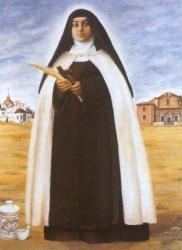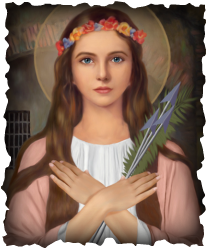
Taken from OCARM.ORG
 Blessed Maria Sagrario of St. Aloysius Gonzaga was born in Lillo, Spain, January 8,1881, to Ricardo Moragas and Isabel Cantarero, the third of four children.Following in her father's footsteps, she became a student of pharmacy, excelling in this field, and became one of the first women in Spain to become a pharmacist. Although she had excellent prospects in pharmacy, and much ability, she eventually discerned a call to the religious life, and after some necessary delay to aid her family she was admitted as a postulant to the Carmel of St Anne and St Joseph in Madrid, in 1915. She was solemnly professed on the Feast of the Epiphany, January 6th, 1920.She became prioress of her community in 1927, and novice-mistress in 1930. She frequently told her novices of her desire to be a martyr. Just before the outbreak of the Spanish Civil war, with its corresponding wave of virulent religious persecutions, she was elected prioress for the second time on 1 July 1936. On July 20th of that same year, the convent was attacked by a mob. Mother Maria Sagraria spirited her sisters to safety and sought shelter with one of them at the home of that sister's parents. She was arrested, along with the other sister, on August 14th. Surviving testimony well documents her serenity and abandonment to God's will. Under interrogation she staunchly refused to betray anyone, and was executed by being shot on the following day, August 15th, the Feast of the Assumption of the Blessed Virgin Mary. Taken from OCARM.ORG
0 Comments
 Little is known of her life, and the information was have was received by private revelation from her. Martyred at about age 14 in the early days of the Church. In 1802 the remains of a young woman were found in the catacomb of Saint Priscilla on the Via Salaria, Rome, Italy. It was covered by stones, the symbols on which indicated that the body was a martyr named Saint Philomena. The bones were exhumed, cataloged, and effectively forgotten since there was so little known about the person. In 1805 Canon Francis de Lucia of Mugnano, Italy was in the Treasury of the Rare Collection of Christian Antiquity (Treasury of Relics) in the Vatican. When he reached the relics of Saint Philomena he was suddenly struck with a spiritual joy, and requested that he be allowed to enshrine them in a chapel in Mugnano. After some disagreements, settled by the cure of Canon Francis following prayers to Philomena, he was allowed to translate the relics to Mugnano. Miracles began to be reported at the shrine including cures of cancer, healing of wounds, and the Miracle of Mugnano in which Venerable Pauline Jaricot was cured a severe heart ailment overnight. Philomena became the only person recognized as a Saint solely on the basis of miraculous intercession as nothing historical was known of her except her name and the evidence of her martyrdom.
Others with known devotion to her include
Taken from Saints.SQPN.com |
Archives
May 2016
Categories
All
|
Ad Jesum Per Mariam - Catholic Lay Ministry. All Rights Reserved Copyright © 2016. This Website is best viewed with Mozilla Firefox
